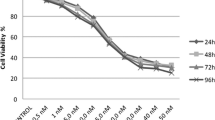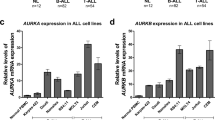Abstract
Although the response rates of chemotherapy in patients with acute T-lymphoblastic leukemia (T-ALL) have improved significantly, the outcome of these patients is still poor. Previous studies suggested that baicalein could inhibit the growth of several cancers, while its effect on T-ALL cells remains unclear. We used Jurkat cells as an in vitro model of T-ALL. Cell counting kit-8 assay and cytometric analysis with Annexin V-FITC/PI double staining were used to investigate the proliferation and apoptosis of Jurkat cells treated with increasing concentration of baicalein for indicated time. RT-PCR and western blotting was used to test the expression of Wnt/β-catenin associated genes and proteins. In cell viability assay, baicalein could inhibit the proliferation of Jurkat cells both in dose- and time-dependent manners. In cell apoptosis assay, baicalein could stimulate apoptosis of Jurkat cells both in dose- and time-dependent manners. Moreover, we demonstrated that baicalein could down-regulated the mRNA and protein levels of β-catenin and its widely accepted downstream targets (c-Myc, cyclin D1, and Axin2) in dose-dependent manners. These results proved that baicalein might be a potential choice for the treatment of T-ALL.




Similar content being viewed by others
References
You MJ, Medeiros LJ, Hsi ED (2015) T-lymphoblastic leukemia/lymphoma. Am J Clin Pathol 144(3):411–22
Brunning RD (2003) Classification of acute leukemias. Semin Diagn Pathol 20(3):142-53
Bleckmann K, Schrappe M (2016) Advances in therapy for Philadelphia-positive acute lymphoblastic leukaemia of childhood and adolescence. Br J Haematol 172(6):855-69
Ge X, Wang X (2010) Role of Wnt canonical pathway in hematological malignancies. J Hematol Oncol 3:33
Ashihara E, Takada T, Maekawa T (2015) Targeting the canonical Wnt/β-catenin pathway in hematological malignancies. Cancer Sci 106(6):665–71
Liu Y, Zhang L, Meng Y, Huang L (2015) Benzyl isothiocyanate inhibits breast cancer cell tumorigenesis via repression of the FoxH1-mediated Wnt/β-catenin pathway. Int J Clin Exp Med 8(10):17601–11
Denysenko T, Annovazzi L, Cassoni P, Melcarne A, Mellai M, Schiffer D (2016) WNT/β-catenin signaling pathway and downstream modulators in low- and high-grade glioma. Cancer Genomics Proteomics 13(1):31–45
Fang L, Zhu Q, Neuenschwander M, Specker E, Wulf-Goldenberg A, Weis WI, von Kries JP, Birchmeier W (2015) A small-molecule antagonist of the β-catenin/TCF4 interaction blocks the self-renewal of cancer stem cells and suppresses tumorigenesis. Cancer Res 76(4):891-901
Yang K, Wang X, Zhang H, Wang Z, Nan G, Li Y, Zhang F, Mohammed MK, Haydon RC, Luu HH, Bi Y, He TC (2016) The evolving roles of canonical WNT signaling in stem cells and tumorigenesis: implications in targeted cancer therapies. Lab Invest 96(2):116–36
Wang MH, Li LZ, Sun JB, Wu FH, Liang JY (2014) A new antioxidant flavone glycoside from Scutellaria baicalensis Georgi. Nat Prod Res 28(20):1772–6
Wu JY, Tsai KW, Li YZ, Chang YS, Lai YC, Laio YH, Wu JD, Liu YW (2013) Anti-bladder-tumor effect of baicalein from scutellaria baicalensis georgi and its application in vivo. Evid Based Complement Alternat Med 2013:579751
Zheng YH, Yin LH, Grahn TH, Ye AF, Zhao YR, Zhang QY (2014) Anticancer effects of baicalein on hepatocellular carcinoma cells. Phytother Res 28(9):1342–8
Kim SD, Lee YJ, Baik JS, Han JY, Lee CG, Heo K, Park YS, Kim JS, Ji HD, Park SI, Rhee MH, Yang K (2014) Baicalein inhibits agonist- and tumor cell-induced platelet aggregation while suppressing pulmonary tumormetastasis via cAMP-mediated VASP phosphorylation along with impaired MAPKs and PI3K-Akt activation. Biochem Pharmacol 92(2):251–65
Chen H, Gao Y, Wu J, Chen Y, Chen B, Hu J, Zhou J (2014) Exploring therapeutic potentials of baicalin and its aglycone baicalein for hematological malignancies. Cancer Lett 354(1):5–11
Li-Weber M (2009) New therapeutic aspects of flavones: the anticancer properties of Scutellaria and its main active constituents Wogonin, Baicalein and Baicalin. Cancer Treat Rev 35(1):57–68
Ma Z, Otsuyama K, Liu S, Abroun S, Ishikawa H, Tsuyama N, Obata M, Li FJ, Zheng X, Maki Y, Miyamoto K, Kawano MM (2005) Baicalein, a component of Scutellaria radix from Huang-Lian-Jie-Du-Tang (HLJDT), leads to suppression of proliferation and induction of apoptosis in human myeloma cells. Blood 105(8):3312–8
Liu S, Ma Z, Cai H, Li Q, Rong W, Kawano M (2010) Inhibitory effect of baicalein on IL-6-mediated signaling cascades in human myeloma cells. Eur J Haematol 84(2):137–44
Xu CP, Cai HL, He L, Ma Z, Liu SQ (2012) Effect of baicalein on proliferation and migration in multiple myeloma cell lines RPMI 8226 and U266 cells. Zhonghua Xue Ye Xue Za Zhi 33(11):938–43
Du YW, Chen JG, Bai HL, Huang HY, Wang J, Li SL, Liu GC, Jiang Q, Chai J, Zhao YP, Ma YF (2011) A novel agonistic anti-human death receptor 5 monoclonal antibody with tumoricidal activity induces caspase- and mitochondrial-dependent apoptosis in human leukemia Jurkat cells. Cancer Biother Radiopharm 26(2):143-52
Chen YJ, Wu CS, Shieh JJ, Wu JH, Chen HY, Chung TW et al (2013) Baicalein triggers mitochondria-mediated apoptosis and enhances the antileukemic effect of vincristine in childhood acute lymphoblastic leukemia CCRF-CEM cells, Evid. Based Complement. Alternat Med 2013:124747
Li C, Shi X, Zhou G, Liu X, Wu S, Zhao J (2013) The canonical Wnt-beta-catenin pathway in development and chemotherapy of osteosarcoma. Front Biosci (Landmark Ed) 18:1384–91
Takahashi-Yanaga F, Sasaguri T (2008) GSK-3beta regulates cyclin D1 expression: a new target for chemotherapy. Cell Signal 20(4):581–9
Bedewy AM, Mostafa MH, Saad AA, El-Maghraby SM, Bedewy MM, Hilal AM, Kandil LS (2013) Association of cyclin D1 A870G polymorphism with two malignancies: acute lymphoblastic leukemia and breast cancer. J BUON 18(1):227–38
Elsayed GM, Ismail MM, Moneer MM (2011) Expression of P-glycoprotein, cyclin D1 and Ki-67 in acute lymphoblastic leukemia: relation with induction chemotherapy and overall survival. Indian J Hematol Blood Transfus 27(3):157–63
Costa CB, Casalta-Lopes J, Andrade C, Moreira D, Oliveira A, Gonçalves AC, Alves V, Silva T, Dourado M, Nascimento-Costa JM, Sarmento-Ribeiro AB (2012) Farnesyltransferase inhibitors: molecular evidence of therapeutic efficacy in acute lymphoblastic leukemia hrough cyclin D1 inhibition. Anticancer Res 32(3):831–8
Tetsu O, McCormick F (1999) Beta -catenin regulates expression of cyclin D1 in colon carcinoma cells. Nature 398(6726):422-6
Leung JY, Kolligs FT, Wu R, Zhai Y, Kuick R, Hanash S, Cho KR, Fearon ER (2002) Activation of AXIN2 expression by beta-catenin-T cell factor. A feedback repressor pathway regulating Wnt signaling. J Biol Chem 277(24):21657–65
Ng OH, Erbilgin Y, Firtina S, Celkan T, Karakas Z, Aydogan G, Turkkan E, Yildirmak Y, Timur C, Zengin E, van Dongen JJ, Staal FJ, Ozbek U, Sayitoglu M (2014) Deregulated WNT signaling in childhood T-cell acute lymphoblastic leukemia. Blood Cancer J 4, e192
Rennoll S, Yochum G (2015) Regulation of MYC gene expression by aberrant Wnt/β-catenin signaling in colorectal cancer. World J Biol Chem 6(4):290–300
Cairo S, Armengol C, Buendia MA (2012) Activation of Wnt and Myc signaling in hepatoblastoma. Front Biosci (Elite Ed) 4:480–6
Acknowledgments
This work was supported by the Research Fund from the National Natural Science Foundation of China (No. 81470007).
Author information
Authors and Affiliations
Corresponding authors
Ethics declarations
Conflict of interest
The authors declare that they have no conflict of interest.
Additional information
Xiaoping Liu and Shengcai Liu contributed equally to this work.
Rights and permissions
About this article
Cite this article
Liu, X., Liu, S., Chen, J. et al. Baicalein suppresses the proliferation of acute T-lymphoblastic leukemia Jurkat cells by inhibiting the Wnt/β-catenin signaling. Ann Hematol 95, 1787–1793 (2016). https://doi.org/10.1007/s00277-016-2766-z
Received:
Accepted:
Published:
Issue Date:
DOI: https://doi.org/10.1007/s00277-016-2766-z




